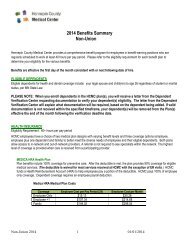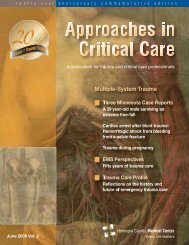Ischemic Stroke - Hennepin County Medical Center
Ischemic Stroke - Hennepin County Medical Center
Ischemic Stroke - Hennepin County Medical Center
You also want an ePaper? Increase the reach of your titles
YUMPU automatically turns print PDFs into web optimized ePapers that Google loves.
Case Reports<br />
In normal adults, ICP is 20mmHg. Cerebral perfusion pressure (CPP)<br />
is a clinical marker for the adequacy of cerebral<br />
blood flow. (CPP = MAP - ICP). Cerebral<br />
blood flow is normally maintained at a relatively<br />
constant level by vascular autoregulation<br />
over a wide range of CPP (50-100 mmHg).<br />
When intracranial hypertension develops,<br />
cerebral blood flow decreases, leading to<br />
hypoperfusion and ischemic injury. Therefore<br />
in the presence of ICP, CPP should be maintained<br />
between 60-75 mmHg.<br />
Management of the cerebral edema and associated<br />
ICP is critical to minimize worsening the<br />
ischemic deficit. An important early goal in this<br />
management of ICP is placement of a monitoring<br />
device that improves insight into the patient's<br />
condition and can guide the therapies needed<br />
to maintain adequate CPP and oxygenation.<br />
Patients should be kept euvolemic and slightly<br />
hyperosmolar (295-305 mOsm/L). Hypertonic<br />
saline acutely lowers ICP but is unproven in<br />
longterm outcomes. Cerebral metabolic<br />
demand, and consequently cerebral oxygen<br />
consumption, can be reduced by sedating<br />
patients. Blood pressure, especially when<br />
hypertensive, needs to be carefully managed.<br />
The optimal blood pressure in these patients<br />
is still a matter of debate. Some argue that<br />
lowering the sBP will help decrease the ICP<br />
and improve outcomes. However, others argue<br />
that inducing systemic hypertension may<br />
increase cerebral perfusion and is more important.<br />
Osmotic diuretics such as mannitol can<br />
be used to draw free water from the cerebral<br />
tissues back into the vascular space where it<br />
can be managed by the kidneys. Despite<br />
occasional use, glucocorticoids have not been<br />
shown to improve outcomes and may increase<br />
the risk of infections, so generally should be<br />
avoided. While hypocapnia (PaCO2 between<br />
26-30 mmHg), induced through hyperventilation,<br />
leads to vasoconstriction and a decrease<br />
in intracranial blood volume in the early<br />
management of an acute stroke, it is often<br />
counter to the need to maintain cerebral perfusion<br />
and is probably best avoided. Prophylactic<br />
therapy for seizures in the setting of large<br />
hemispheric stroke is unproven, but sometimes<br />
still administered.<br />
Removal of CSF can be immensely useful in<br />
lowering ICP, and is generally easily done<br />
through a ventriculostomy draining to gravity.<br />
The drainage should be done slowly at a rate<br />
of 1-2 mL/minute in cycles of 2-3 minutes<br />
draining with a similar period of being<br />
clamped. This can be repeated until ICP is
















